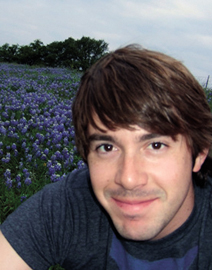After a nationwide search, researchers Patrick Hopkins and Bryan Kaehr have been selected as Sandia’s 2008 Truman Fellows. They join eight other researchers who have been appointed since the President Harry S. Truman Fellowship in National Security Science and Engineering was established in 2004.
Patrick earned his PhD in mechanical and aerospace engineering at the University of Virginia in May 2008. His dissertation title was “Scattering processes affecting thermal boundary conductance solid-solid interfaces in nanomaterial systems.”
During his Truman fellowship, Patrick will examine “Interfacial electron and phonon scattering processes in high-powered nanoscale applications” (the title of his research proposal). Patrick will conduct his research in Microscale Science and Technology Dept. 1513. Patrick was a graduate student intern at Sandia in 2007.
Bryan earned his PhD in biochemistry at the University of Texas-Austin in August 2007. His dissertation title was “Defining cellular microenvironments using multiphoton lithography.”
Bryan’s research interests encompass nonlinear photochemistry, biocompatible microfabrication, smart materials, engineered cellular networks and populations, biohybrid nanomaterials, and microdevices. During his Truman fellowship at Sandia, Bryan will focus on “Development and characterization of 3-D, nano-confined multicellular constructs for advanced biohybrid devices” (the title of his research proposal). He will conduct his research in Ceramic Processing & Inorganic Materials Dept. 1815.
Chief Technology Officer and VP in charge of the Truman Fellowship Program Rick Stulen (1000), says he expects Patrick and Bryan will make important contributions to Sandia’s mission — and ultimately to the national interest.
According to the selection committee, Patrick’s proposed research will address crucial issues in the continued reduction in feature size and growth in performance of integrated electronics. The results of his research could have significant impact at Sandia and in US industry on the continued development of innovative nanoscale devices and unique materials.
Bryan will arrive at Sandia with a new and unique technology for building almost any structure with proteins. As the proteins are functionalized the possibilities seem almost endless for making new technology of value to Sandia. His research has been picked up by the widely read science literature and appeared in Scientific American, C&E News, and Biophotonics. This work has brought wide acclaim to him and Jason Shear, his advisor at UT-Austin.
Here are brief descriptions provided by Patrick and Bryan of the work they hope to accomplish during their three-year fellowship at Sandia:
Patrick Hopkins

“The goal of my research is to study how thermal transport in nanostructures is affected by the resistances of interfaces and junctions between two nanomaterials. The large heat fluxes generated from novel nanoelectronic applications are a significant limiting factor in next-generation devices. As such, a greater understanding of the causes of this thermal interface resistance is imperative for design and development of high-powered sensor, signal processing, and energy conversion systems.
“During my Truman fellowship, I will examine heat transfer processes around structurally imperfect regions at interfaces involving both traditional and novel nanostructures. Nanomaterials and structures will be fabricated subject to different deposition and processing conditions to induce various degrees of structural variants around the nanomaterial interfaces. The electronic and phononic interfacial processes will then be measured with various electrical and optical techniques. The experimental data will be supplemented with theoretical quantum transport models.
“The Truman fellowship gives me the necessary means to accelerate my research in nanoscale heat transfer and significantly advance the current physics involved with high-flux device design. This multidisciplinary research project will allow me to interact with the world-class scientists at Sandia and give me the opportunity to conduct experiments in state-of-the-art laboratory environments. I am extremely pumped to be given this opportunity and work with fellow Sandians to study this critical aspect of high-powered nanosystems.”
Bryan Kaehr

“This fellowship provides the opportunity to explore an exciting frontier at the cutting edge of materials science and bioengineering. Cells and microorganisms employ nanomachinery of enormous variety and sophistication to sense, navigate, communicate, and adapt to the environment. The ability to control and manipulate cellular machinery in artificial systems may hasten the development of smaller, more responsive sensors and actuators, and those are important goals for nanotechnology.
“A promising avenue for research in this area is to integrate whole cells into devices and materials, an approach that confers a number of advantages over other approaches that have been tried with only limited success. In order to develop a new platform for the fabrication and manipulation of robust, whole-cell biohybrid materials, I will take advantage of recent breakthroughs accomplished at Sandia that enable cells to direct the assembly of functional interfaces to solid-state nanomaterials.
“My efforts at Sandia will focus on incorporating complex cellular functions — such as replication, differentiation and intercellular communication — into solid-state platforms. The development of this technology will permit the design of solid-state cell-based circuitry to be explored across a broad spectrum of applications including environmental sensing, biocomputation, bioenergy conversion, and artificial tissue fabrication.
“This fellowship is a great honor and tremendous opportunity for learning and interacting with some of the best scientists and engineers working today. I plan to take advantage of the wide range of expertise at Sandia and am confident that this research will result in valuable insights, tools, and technologies important for Sandia’s missions.”